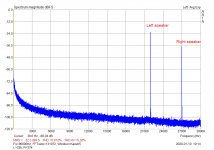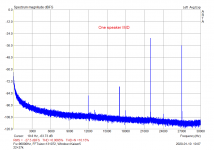With what? You just said you couldn't use it and now you replaced the "741's" not noticing they were dual op-amps. Do you make this up as you go along?
so literal.... yes, i know they are dual. Ok should have said 747.
I have not used the miniDSp at all after changing opamps. Ordered another brand with better over-all performance. I hope.
THx-RNMarsh
I have not used the miniDSp at all after changing opamps. Ordered another brand with better over-all performance.
Was the smell, the taste, or the texture the problem?
The level of the signal. If you hit a bell for example, the tone rises very fast to full amplitude, then slowly decays to zero. This is an envelope with a steep front slope. That fast envelope rise causes high frequency components.
If it is too fast a rise, the filter will be unhappy and will stop some of it.
There is a trade off between the frequency created and how fast it's amplitude will rise.
Scott, in his plot, showed the difference between filter in and out. That plot, I called the Gibbs envelope, is a direct measure of the filter removing stuff that exceeds the filter cutoff. I propose using it to look at specific music or instruments to determine is the frequency/envelope combined to make frequency side bands that exceeded the filter. If it does, raising the filter break to find out where it stops cutting information will show you the sample rate needed to insure good fidelity.
The only caveat is if the instrument by design creates lots of ultrasonic tones, that would also be rejected.
I can see looking for Gibbs envelope, then examining the waveform to see if it's just ultrasonics, or if the signal envelope caused the action.
Jn
Thanks!
Ok so the "fish" would never "emerge" if you run the signal in slow-mo and watched a level meter follow the *envelope*! The envelope is that path you would travel if you "walked" the signal - right?
Hmm, still wondering... when you use waveform and envelope in the same sentence - must mean they are different for you - how?
//
Was the smell, the taste, or the texture the problem?
All of the above and color, too.
And, the slope characteristics, I wanted more flexibility with individual slopes.
-RM
Last edited:
Cannot (>22Khz) make a difference in a way speakers accelerate ?
Yes, thereby possibly creating IM distortion components in the sub 18Khz range.
Hans
Yes, thereby possibly creating IM distortion components in the sub 18Khz range.
Possibility is not fact.
Cannot make a difference in a way speakers accelerate ?
If you feed speakers with twin or more tone frequencies >22kHz, they will create IM products in audio band. This is the "ultrasound hearing miracle".
All of the above and color, too.
And, the slope characteristics, I wanted more flexibility with individual slopes.
-RM
Given you can program your own biquads what is missing from flexibility? If you really MUST have FIR then some miniDSP products have that as well. I'd be interested to know what you think you need that is missing.
If you feed speakers with twin or more tone frequencies >22kHz, they will create IM products in audio band. This is the "ultrasound hearing miracle".
Exactly my idea. 😀
Hans
Perhaps you could get some funding for some cutting edge research? Think of the emotional pleasure it could bring......maybe. Are you prepared for Jacob's Wrath - Trailer on Vimeo
Last edited:
If you feed speakers with twin or more tone frequencies >22kHz, they will create IM products in audio band. This is the "ultrasound hearing miracle".
That's a pretty cool method of explanation. Let's see, if you feed amplifiers with twin or more tone frequencies >22kHz, they will create IM products in the audio band. This is the "amplifier sound difference miracle".
Yep, works and I like it.
Send me your "audible difference miracle" that you would like to have resolved and I'll do it. It most likely will only take one to three sentences ....😎
@scott wurcer;
Fourier keeps track of phase exactly and always.
Fourier does, but the usual FFT result graphs do not and a lot of people looking at the images (and try to interpret) tend to forget about the phase information.
Exactly my idea. 😀
Hans
If you feed speakers with twin or more tone frequencies >22kHz, they will create IM products in audio band. This is the "ultrasound hearing miracle".
That's a pretty cool method of explanation. Let's see, if you feed amplifiers with twin or more tone frequencies >22kHz, they will create IM products in the audio band. This is the "amplifier sound difference miracle".
The problem is, my dear Jakob, that I can easily demonstrate that it is the speaker that creates IM. The amp IM is about 50dB better than that of the speaker.
2 plots, one with L channel playing 22kHz and R channel 27kHz. This shows that microphone is clean and does not create distortion.
2nd plot, one speaker plays 22+27kHz tones and we can see IMD products in audio band.
Dear Jakob, this is the issue that Oohashi did not take into account. He should have used 2 speakers instead of one, one for ultrasound, one for <20kHz programme.
You know I do not need weeks of discussions to prove somebody wrong.
Attachments
Perhaps you could get some funding for some cutting edge research? Think of the emotional pleasure it could bring......maybe.
No need for funding, such trivialities I prepare in 10 minutes.
If you feed speakers with twin or more tone frequencies >22kHz, they will create IM products in audio band. This is the "ultrasound hearing miracle".
Is it audible?
Of course all speaker is non linear, so it should make IM of any 2 or more frequency.
Is it audible?
Of course all speaker is non linear, so it should make IM of any 2 or more frequency.
The audibility is questionable. Yes in case of quiet environment and not too far from speakers. Probably not if masked by music programme.
The audibility is questionable. Yes in case of quiet environment and not too far from speakers. Probably not if masked by music programme.
Those levels will be quit audible with music... rarely will there be only 2 freqs. A lot of HF freq are there. From imperfect LPF from CD player.
I have said this already here recently and other forums... it causes IM. But only if you have a VFA with falling open loop gain such that it become more and more non-linear amp in region >22Khz. many CfA/CMA are linear into HF and beyond and sound cleaner in comparison.
Alternately, a LPF on VFA PA input gives similar sounding performance then.
THx-RNMarsh
Last edited:
That LPF depends on the DAC.Those levels will be quit audible with music... rarely will there be only 2 freqs. A lot of HF freq are there. From imperfect LPF from CD player.
This filter only blocks everything above Fs/2, so when using a DAC that converts all input to a higher frequency, the filter will also be wider Accordingly.
So when your input file is 96 or 192, many ultrasonics will pass unfiltered.
Forget the amp being used.I have said this already here recently and other forums... it causes IM. But only if you have a VFA with falling open loop gain such that it become more and more non-linear amp in region >22Khz. many CfA/CMA are linear into HF and beyond and sound cleaner in comparison.
Alternately, a LPF on VFA PA input gives similar sounding performance then.
IM from the speakers will be much higher as PMA already mentioned.
Hans
The units of angles and radians are unimportant to the argument. The identity doesn't care. All the user has to do is scale properly, 180/pi conversion.When I ask my calculator to take a sine it needs to know the units I am using, and Hz is not a choice. So exactly what does your "sine identity" actually show?
I think my question actually is interesting, and your answer is unsatisfying. I think the trigonometric identity equation you dug up is, by definition, exactly correct, and unrelated to your example.
The identity is the key for others to understand. It details why, when I input sin(20k)*sin(2.5k), the filter sees and removes 22.5k.
It is simple AM radio stuff.
Jn
Too much of a blanket.I will say this again, if you use a math algorithm to create a signal and sample it at 44.1kHz it will contain images and if >22050Hz aliases. End of story you can not use this data to prove anything.
This story contains two parts. First is the filter before the sampler. It prevents violating nyquist.
The math algorithm is a simple one which by definition, produced two pure sines.
The filter removes one. All this has nothing to do with sample rate. The filter sample rate needs to be high enough to NOT remove pertinent envelope information. If the filter worked at a gig rate but removes 22.5k, the same thing will happen.
Your I/O difference Gibbs plot shows exactly where the filter removes content, the Gibbs envelope might be used to determine if it's fundamental frequency content being removed (which we do not care about), or envelope created sidebands.
Jn
Last edited:
That LPF depends on the DAC.
This filter only blocks everything above Fs/2, so when using a DAC that converts all input to a higher frequency, the filter will also be wider Accordingly.
So when your input file is 96 or 192, many ultrasonics will pass unfiltered.
Forget the amp being used.
IM from the speakers will be much higher as PMA already mentioned.
Hans
Thats a good point about BW of LPF. All the more reason to have linear wideband PA.
Regarding speaker interfacing issues; being a separate subject with separate solutions. All - not one or the other - causes need to be addressed.
THx-RNMarsh
Last edited:
- Status
- Not open for further replies.
- Home
- Member Areas
- The Lounge
- John Curl's Blowtorch preamplifier part III

